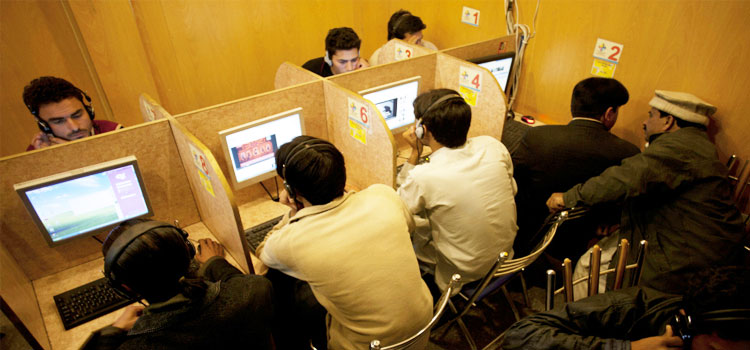Thanks to poor reporting and in-availability of data and statistics, Pakistan was ranked among the lowest in the world on broadband access index by a report published yesterday by Broadband Commission in Geneva.
Report titled as “The State of Broadband 2015: Broadband as a Foundation for Sustainable Development” is published annually by Broadband Commission for digital development, a body that was setup by United Nation’s ITU and UNESCO to measure and determine the digital development of the world.
Unfortunately the data that was made available to the commission was outdated and no proper efforts were made by the concerned authorities (mainly PTA) to get the figures corrected.
Incidentally we just covered this week that Pakistan lives without data and statistics and there’s dire need of updating our records for various heads including the basic information about the number of internet users in the country.
Unfortunately the broadband data for Pakistan that was made available to the commission is outdated
For instance, according the the report, percentage of Pakistanis with access to mobile broadband is 5.1% — which is incorrect as according to PTA, there were 14.61 million 3G/4G users in Pakistan by end of July 2015. Which should translate into at least 8% of mobile broadband penetration.
As mentioned above, Pakistan ranked low on the index of 192 countries that were surveyed for the broadband access.
Here’s how Pakistan did on the index:
- With 1.1% penetration, Pakistan ranked at 135th for fixed broadband subscriptions per 100 Capita
- With 5.1% penetration, Pakistan ranked at 151st Position for Mobile Broadband Subscriptions per 100 Capita
- With 13.2$ penetration, Pakistan ranked at 83rd Slot for percentage of Households with Internet access
- With 13.8% penetration, Pakistan ranked at 151st for percentage of individuals who use internet
- With 13.8% penetration, Pakistan ranked at 104th in developing countries for percentage of individuals who use internet
Report Findings
Report said that mobile broadband and Facebook usage continued to grow and mobile cellular subscriptions exceeded 7 billion for the first time during 2015, growth in both mobile cellular subscriptions and Internet usage has slowed sharply.
Following are the highlights from the report:
Internet Growth
- By end 2015, some 3.2 billion people will be online, equating to over 43.4% of the total world population, and up from 2.9 billion a year earlier (almost 40.6% of the population).
- In the developing world, Internet penetration will surpass 35.3% by the end of 2015; penetration will still be under 10% at 9.5% in the UN-designated Least Developed Countries, however.
- Even though Internet penetration is approaching saturation in the developed world, with 82.2% of the population online, the global target of 60% set by the Broadband Commission in 2011, to be achieved by 2015, is unlikely to be achieved before 2021 at the earliest.
- Internet user penetration in the developing world is unlikely to achieve the Broadband Commission target of 50% before 2020. By the end of 2015, there will still be 57% of the world’s population – or four billion people – still offline.
- Household Internet access in developed countries is close to saturation, with more than 81.3% of households connected. The proportion of households in the developing world with Internet access has increased from 31.5% at the end of 2014 to over 34.1% a year later – still well short of the Broadband Commission target of 40% by 2015.
- Household connectivity figures mask strong disparities – fewer than 7% of households in LDCs have access, while in sub-Saharan Africa only 1 in 9 households is connected. According to Point Topic, Asia has the largest total number of broadband-connected homes, with nearly as many in total as Europe and the Americas combined.
- The gender gap in Internet users is proving stubbornly persistent, with an estimated 200 million more men online than women as recently as 2013; one major problem is that sex-disaggregated data are not yet widely reported by national governments and statistics agencies.
Mobile Growth
- ITU estimates that there will be a total of almost 3.5 billion mobile broadband subscriptions by end 2015. Industry analysts predict 6.5 billion mobile broadband (3G/4G/5G) subscriptions by 2019, making mobile broadband the fastest growing ICT service in history.
- Asia-Pacific now accounts for half of all mobile broadband subscriptions, up from just under 45% at the end of 2014. In January 2015, China Mobile became the world’s largest mobile operator by number of subscribers.
- Smartphones now dominate the mobile device market, and will continue to do so for the foreseeable future.
Affordability
- Broadband is becoming more affordable: over the five years since the creation of the Broadband Commission in 2010, fixed broadband prices as a share of GNI per capita have dropped by 65% on average worldwide.
- By 2014, most countries in the world had reached the Commission’s target of basic fixed-broadband service at less than 5% of monthly GNI per capita – however, in many of the world’s poorest countries, where broadband could potentially have the greatest benefit in terms of bridging development gaps, even basic broadband service remains prohibitively expensive.
- There also remain very big differences in affordability within countries – even in countries where the 5% target has been met, there are often parts of the country or communities where affordable broadband has not been achieved, especially in rural and remote areas.
- By the end of 2014, a basic fixed broadband subscription cost less than 5% of average GNI per capita in 111 countries, of which 44 were developed nations and 67 were developing countries (compared with 57 developing countries at the end of 2013, and 48 developing countries at the end of 2012).
Broadband policy
- With 148 countries having adopted a national Plan or strategy by mid-2015, and a further six countries planning to adopt a Plan. A total of 42 countries still do not have any form of Plan.
- Although there has been good growth in the number of countries with a Plan, a substantial number of Plans (many of which were introduced around 2010) are reaching the end of their term this year in 2015 (e.g. Belarus, Belgium, Croatia, Finland, Mongolia, Paraguay and Singapore). The ‘succession strategy’ for many of these Plans is unclear.
- Future Internet users are likely to come from less well-educated, less urban backgrounds and from a base of languages and dialects outside the handful of languages that currently dominate online services and content (including Chinese, English, Spanish, French and Russian). The large majority of languages are without a significant online presence matching their real-world speaker base.
- The report finds that growth in the range of languages available for some of the main online services is not matching the growth in Internet use. Indeed, the paucity of online representation of a greater diversity of languages is a major obstacle to increasing demand for relevant content and the take-up of broadband services.
Broadband and ICT industry
- The telecoms industry continues to grow strongly in terms of penetration and uptake. According to IDC, the sector was worth an estimated US$1.67 trillion at end 2013, and is growing by 1-2% per year, driven mainly by China and emerging markets.
- Broadband growth is not consistent across regions or across technologies – for example, in Europe, some incumbent telcos are seeing revenues decline, while cable operators and ‘altnets’ are being helped by TV revenue growth (cable) or more agile business models linked to their smaller size (altnets).
- New advances in satellite technology are playing a key role in helping to deliver broadband in rural and isolated areas (even in developed countries). Satellites have the advantage of huge reach over massive areas, enabling relatively cost-effective connection of many subscribers, and faster roll-out than a network of point-to-point connections. They can also help overcome problems of difficult terrain in hard-to-connect regions, such as mountainous areas.
- The ‘Internet of Things’ (IoT) is growing fast, with Deloitte predicting that one billion IoT devices will be shipped in 2015, up 60% on 2014 figures. ITU forecasts 25 billion networked devices by 2020 – meaning connected devices could outnumber connected people by 6:1.
- For every person connecting to the Internet over the next five years, ten as many times devices will connect. Indeed, some industry observers are concerned that the Internet of Things may open up a new digital divide in terms of access and use of connected devices.
Complete report can be downloaded from this link.






















Thanks to zardari nawaz.
People going on internet = less votes for zardari and nawaz sheef
I think, there must be Indians in Broadband Commission in Geneva who provide false data about Pakistan. Penetration of internet is increasing very rapidly in Pakistan. More than 10 m people in small towns and villages are using internet through mobiles 2/3/4 G and about 20 m in cities. Look at the remittances which are increasing between 15 and 18 percent per year. It is because of call centers which are coming up in villages and small towns where there are no taxes and no rent as they use rooms of their homes; educated boys and girls are available at cheaper pay and electricity is on solar. Mobile penetration is also above 75% in Pakistan whereas 30 m people returned their mobiles in 2013 because they cannot afford to pay even 100 rupees per month.
We are always in a state of denial. It is because of this denial that the FBR recently doubled the iport duty on networking equipment. If 30 m people returned their mobiles because they cannot afford to pay 100 rupees per month, then the government should pity these people and remove taxes on mobile phones which are the highest in the world.
30 m people returned their mobiles in INDIA in 2013 because they cannot afford to pay even 100 rupees per month.